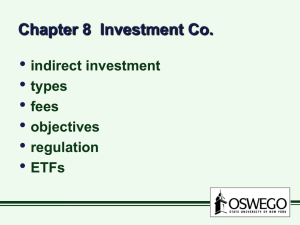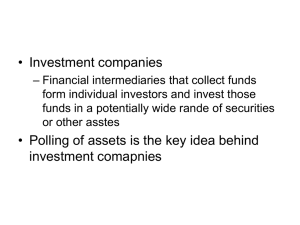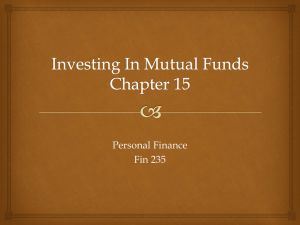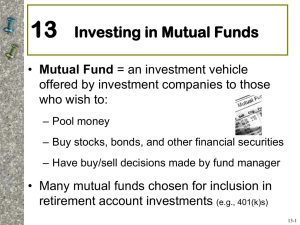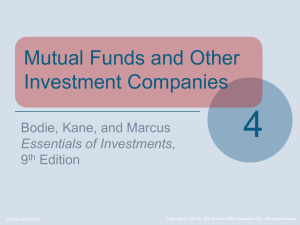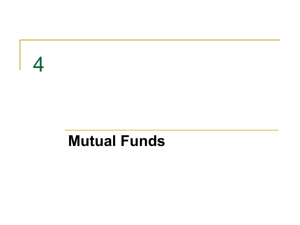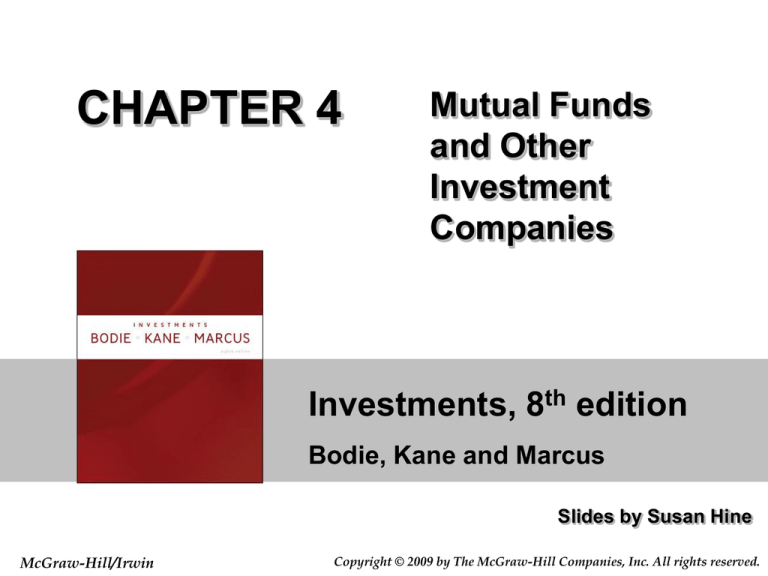
CHAPTER 4
Mutual Funds
and Other
Investment
Companies
Investments, 8th edition
Bodie, Kane and Marcus
Slides by Susan Hine
McGraw-Hill/Irwin
Copyright © 2009 by The McGraw-Hill Companies, Inc. All rights reserved.
Investment Companies
-Collecting funds from individuals
-Investing in a big portfolio
-How it works
• Investment company forms portfolio
• Sells investors shares in the portfolio
• investors have claim to the portfolio,
proportional to their number of shares
4-2
Investment Companies
• These companies perform several
important functions for investors:
– Administration & record keeping: capital
gains, dividends and so on
– Diversification & divisibility:i.e. by pooling
of assets
– Professional management: security
analysts etc.
– Reduced transaction costs
4-3
Net Asset Value
• Used as a basis for valuation of investment
company shares for
– Selling new shares
– Redeeming existing shares( buying back)
Calculation: NAV=
Market Value of Assets - Liabilities
Shares Outstanding
4-4
Types of Investment Companies
• Unit Investment Trusts: pool of money invested
in portfolio; its portfolio is fixed, unmanaged.
-Brokerage firm buys and forms portfolio
-Sells shares in that trust called units or
redeemable trust certificates
-All money from portfolio is distributed to share
holders by trustee, i.e. company which manages
portfolio
e.g.
-Trust bourght portfolio for $ 5 million
-Sells 5,000 shares at $1,030 per share
-3% premium per share obtained by trustee
4-5
Types of Investment Companies
• Managed Investment Companies; portfolio is
managed
• Board of directors, elected by shareholders,
hires management company for fee of 0.2 to
1.5% of assets value
- Open-End (called mutual funds)
• Open-end: shares redeemed, new shares
issued at NAV;
• shares outstanding change when new
shares are issued or old shares are
redeemed
• Priced at Net Asset Value(NAV)
4-6
Types of Investment Companies
- Closed-End
Not redeemed, no new share issue
No change in shares outstanding
• Shares traded on organized exchanges
and can be sold and bought at market price
(unlike open-end mutual funds shares)
• May be priced at Premium or discount to
NAV
Fig 4.1
MKT PRICE: share price
PREM/DISC %: (Price-NAV)/NAV
52 WEEK RETURN: based on percentage price
change + dividend
4-7
Figure 4.1 Closed-End Mutual Funds
4-8
Types of Investment Companies
Puzzle of divergence of share price and
NAV
Puzzle of issue price of share above NAV
Naturally, mutual fund share not traded on
organized exchages
4-9
Types of Invest. Companies Continued
• Other investment organizations
Not as organized as investment companies but
similar to them in function
-Commingled funds: units are issued (like shares).
Like open-end, they're trades at NAV.
e.g. money market fund, bond fund, common stock
fund often offered by Bank or insurance
company
-Real estate investment trusts (REITs): equity trust,
mortgage trust
-Like closed-end, issuing shares and investing in
real estates or mortgages
-usu., bank or insurance company forms REIT
4-10
and serves as trust manager and earns fee
Types of Invest. Companies Continued
-Hedge funds
-Like mutual funds but private partnership so
under minimal SEC regulation
-can make heavy use of risky, profitable assets
-very often initial lock-ups
4-11
Mutual Funds—Investment Policies
• Money Market Funds
• Equity Funds
-Sector Funds, Income or Growth Fund
• Bond Funds, often specializing by types
• Balanced Funds, across all secrities
• International(global, regional, emerging market)
• Asset Allocation and Flexible; like balanced but
vary much in portfolios
• Index, forms portfolio of index
4-12
Table 4.1 U.S. Mutual Funds by
Investment Classification
4-13
How Funds Are Sold
• Direct-marketed funds; mails, phone, internet
etc.
• Sales force distributed: brokers, advisers on
commission
-Revenue sharing on sales force
– Potential conflicts of interest
• Financial Supermarkets; sell shares of many
funds
4-14
Costs of Investing in Mutual Funds
• Fee Structure
– Operating expenses; cost of operating
portfolio, inc. administration and advisory
cost
– Front-end load:when you buy a share
– Back-end load:when you redeem a share
12 b-1 charges, authorized by SEC, up to 1%
of average NAV per year
• distribution costs paid by the fund
• Alternative to a load
• Funds offer several combination of
4-15
Fees and Mutual Fund Returns
NAV1 - NAV0 + Income and capital gain distributions
Rate of return =
NAV0
90
80
70
60
50
40
30
East
West
North
20
10
0
1st Qtr 2nd Qtr 3rd Qtr 4th Qtr
4-16
Fees and Mutual Fund Returns:
An Example
Initial NAV = $20
Income distributions of $.15
Capital gain distributions of $.05
Ending NAV = $20.10:
$20.10 - $20.00 + $.15 + $.05
Rate of Return =
= 1.5%
$20.00
4-17
Table 4.2 Impacts of Costs on
Investment Performance
4-18
Trading Scandal with Mutual Funds
-Every day, calculates NAV at the close of the
market.
-All orders of the day are executed at that NAV
after the close of the market.
• Late trading – allowing some investors to buy or
sell after market closes and NAV fixed
• Market timing – allowing investors to buy or sell
on stale NAV after the lose of the regional
markets in International funds (e.g.Japanese)
• Why allow? Management fee for big investment
• Net effect is to transfer value from other
shareholders to privileged traders
4-19
Potential Reforms
• Strict 4:00 PM cutoff with late orders
executed the following trading day
• Fair value pricing: in NAV, adjust prices of
securities of closed markets to reflect impact
of prices of securities in still open markets
• Imposition of redemption fees of more than
2% for shares sold within a week of buy, paid
directly to funds not to management company
4-20
Taxation on Mutual Fund Income
• Pass-through status under the U.S. tax code
i.e. taxes are paid only by investor, not by fund
• High turnover(replacement of assets in the
fund) leads to high tax inefficiency
• Last decade turnover: 60% in equity funds,
2% in index funds
4-21
Exchange Traded Funds
• ETF allow investors to trade index portfolios like
shares of stock (continuous price quote)
• Examples – Spider (for S&P 500), Diamond (for
DJIA), Cube(for NASDAQ 100), WEBS(World
equity benchmark shares)
• Potential advantages
– Lower taxes; redeem many→fund sells
securities→capital gain tax
– Trade continuously +short sale, buying on
margin
– Lower costs; for fund doesn’t market to
investors, who buy from brokers. So low
management fees
• Potential disadvantages
– Prices can depart by small amounts from NAV
4-22
Table 4.3 EFT Sponsors and Products
4-23
Mutual Fund Investment Performance:
A First Look
• Evidence shows that average mutual fund
performance is generally less than broad
market performance
But there are good managers and bad
managers. Then, do the former perform
consistently well? Hence the following test.
• Evidence that performance is consistent from
one period to the next is suggestive but
inconclusive. Table 4.4
4-24
Figure 4.2 Diversified Equity Funds
versus Wilshire 5000 Index
4-25
Table 4.4 Consistency of
Investment Results
4-26
Information on Mutual Funds
• Prospectus+Statement of additional
information (SAI)
• Wiesenberger’s Investment Companies
• Morningstar (www.morningstar.com)
• Yahoo (biz.yahoo.com/funds)
• Investment Company Institute (www.ici.org)
• Directory of Mutual Funds
4-27


